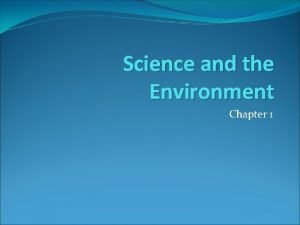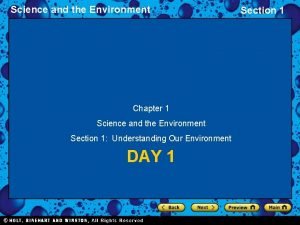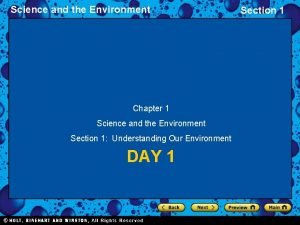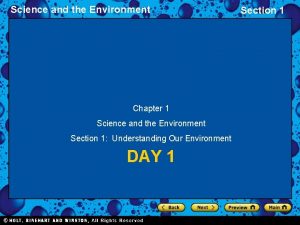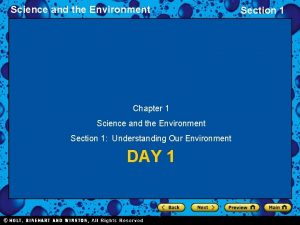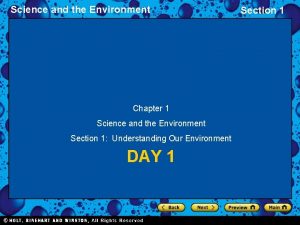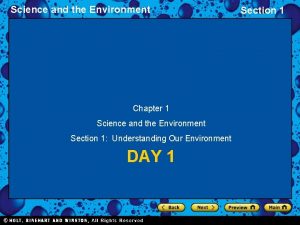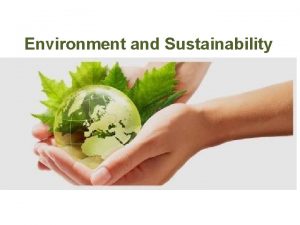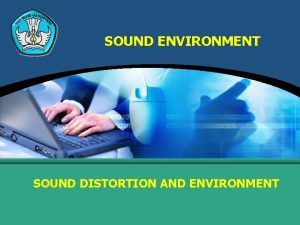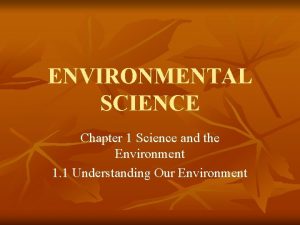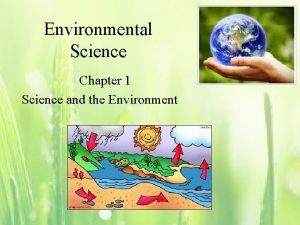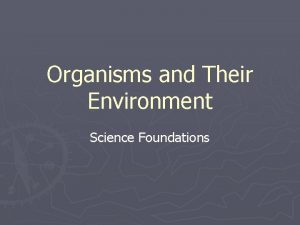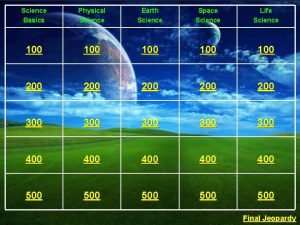SCIENCE AND THE ENVIRONMENT Chapter 1 ENVIRONMENT My


























- Slides: 26

SCIENCE AND THE ENVIRONMENT Chapter 1

ENVIRONMENT My definition: What the book says: Everything around us Includes the natural world as well as things produced by humans.

ENVIRONMENTAL SCIENCE The study of the impact of humans on the environment

THE GOALS OF ENVIRONMENTAL SCIENCE To understand solve environmental problems Accomplished by studying 2 main types of interactions between humans and the environment � How we use natural resources � How our actions alter our environment

ENVIRONMENTAL SCIENCE IS AN INTERDISCIPLINARY SCIENCE. Involves many fields of study � Biology: the study of living organisms � Earth Science: the study of the Earth’s nonliving systems and the planet as a whole � Physics: the study of matter and energy � Chemistry: the study of chemicals and their interactions � Social Science: the study of human populations


ECOLOGY VS. ENVIRONMENTAL SCIENCE Ecology The study of how things interact with each other & their nonliving environment Environmental Science The study of the impact of humans on the environment

EXAMPLES OF HOW FIELDS OF STUDY CONTRIBUTE TO ENVIRONMENTAL SCIENCE A scientist is studying how pollutants travel underground. A scientist is studying fossils to see how Earth’s climate has changed in the past. A scientist is studying how windmills should be designed to provide the most energy. Geology or Geochemistry Paleontology or climatology engineering

EXAMPLES OF HOW FIELDS OF STUDY CONTRIBUTE TO ENVIRONMENTAL SCIENCE Choose an article. Write a short summary (3 -5 sentences). Identify what fields of study are involved in this research/news. Provide evidence from the article to show this involvement.

ENVIRONMENT THROUGH TIME Hunters and Gatherers Agricultural Revolution Industrial Revolution

Effects on the Characteristics Environment Hunter-Gatherers The Agricultural Revolution The Industrial Revolution

Hunter-Gatherers CHARACTERISTICS EFFECTS ON THE ENVIRONMENT � Obtain food by collecting � Altered habitats to meet plants, hunting wild animals, or scavenging their remains � Migrated during the year their needs Ex: burned prairies to prevent tree growth so they could hunt bison � Overhunting may have led to the disappearance of some species of large mammals

The Agricultural Revolution CHARACTERISTICS EFFECTS ON THE ENVIRONMENT � Began to collect seeds & � Habitats were destroyed domesticate animals � Allowed populations to grow at an unprecedented rate � Populations concentrated in smaller areas for farming � Soil loss, floods, water shortages

The Industrial Revolution CHARACTERISTICS EFFECTS ON THE ENVIRONMENT � Shift from using animal � Machinery reduced the sources & running water to fossil fuels � Increased the efficiency of agriculture, industry & transportation � Populations in urban areas grew � Allowed food & other goods to be transported amount of land needed for farming � Pollution � Use of artificial substances, in place of plant & animal products, that caused more problems later (plastics)

Spaceship Earth �Earth can be compared to a giant spaceship Traveling through space Living cargo Limited supplies Unable to dispose of waste or take on new supplies Closed system: nothing comes in, nothing goes out

WHAT ARE OUR MAIN ENVIRONMENTAL PROBLEMS? Can be grouped into 3 categories � Resource depletion � Pollution � Loss of biodiversity

RESOURCE DEPLETION Natural resource � Any natural material that is used by humans � Renewable DEF: Can be replaced relatively quickly by natural processes EX: Fresh water, air, soil, trees, crops, energy from the sun � Nonrenewable DEF: Forms at a much slower rate than the rate that it is consumed EX: Minerals and fossil fuels

POLLUTION DEF: An undesired change in air, water, or soil that adversely affects the health, survival, or activities of humans or other organisms Biodegradable � DEF: Pollutants that can be broken down by natural processes � EX: Human sewage, food wastes Nondegradable � DEF: Cannot be broken down by natural processes � EX: Mercury, lead, some plastics

LOSS OF BIODIVERSITY Biodiversity � DEF: The number & variety of species that live in an area The organisms we share the world with can be considered natural resources. � An extinct species: a nonrenewable resource If current rates of extinction continue, it may cause problems for human populations in the future All species have potential VALUE: economic, ecological, scientific, aesthetic, and recreational value.

SECTION 1 -2 The Environment and Society

TRAGEDY OF THE COMMONS

“THE TRAGEDY OF THE COMMONS” 1968, ecologist Garrett Hardin: � The main difficulty in solving environmental problems is the conflict between the short-term interests of individuals and the long-term welfare of society. Someone or some group has to take responsibility for maintaining a resource. If no one takes that responsibility, the resource can be overused and become depleted.

ECONOMICS AND THE ENVIRONMENT Economic forces influence how we use resources � Supply and Demand The greater the demand for a limited supply of something, the more that thing is worth � Costs and Benefits Cost of environmental solutions can be high A cost-benefit analysis balances the cost of the action against the benefits one expects from it � Risk Assessment Helps us create cost-effective ways to protect our health and the environment

DEVELOPED & DEVELOPING COUNTRIES Developed � Higher average incomes � Slower population growth � Diverse industrial economies � Stronger social support systems � Ex: US, Japan, Canada, countries of Western Europe Developing � Lower average incomes � Simple & agriculturalbased economies � Rapid population growth � Ex: Indonesia, Ethiopia

Developed nations use about 75% of the world’s resources, even though they make up only about 20% of the world’s population. One way to express the differences in consumption between nations: � Ecological footprint Shows the productive area of Earth needed to support one person in a particular country.

A KEY GOAL OF ENVIRONMENTAL SCIENCE The condition in which human needs are met in such a way that a human population can survive indefinitely
 That's my favorite
That's my favorite Chapter 1 science and the environment answer key
Chapter 1 science and the environment answer key Environment vs ecology
Environment vs ecology Chapter 1 science and the environment section 2
Chapter 1 science and the environment section 2 Hát kết hợp bộ gõ cơ thể
Hát kết hợp bộ gõ cơ thể Ng-html
Ng-html Bổ thể
Bổ thể Tỉ lệ cơ thể trẻ em
Tỉ lệ cơ thể trẻ em Chó sói
Chó sói Chụp tư thế worms-breton
Chụp tư thế worms-breton Chúa yêu trần thế alleluia
Chúa yêu trần thế alleluia Kể tên các môn thể thao
Kể tên các môn thể thao Thế nào là hệ số cao nhất
Thế nào là hệ số cao nhất Các châu lục và đại dương trên thế giới
Các châu lục và đại dương trên thế giới Công thức tính độ biến thiên đông lượng
Công thức tính độ biến thiên đông lượng Trời xanh đây là của chúng ta thể thơ
Trời xanh đây là của chúng ta thể thơ Mật thư anh em như thể tay chân
Mật thư anh em như thể tay chân Làm thế nào để 102-1=99
Làm thế nào để 102-1=99 Phản ứng thế ankan
Phản ứng thế ankan Các châu lục và đại dương trên thế giới
Các châu lục và đại dương trên thế giới Thể thơ truyền thống
Thể thơ truyền thống Quá trình desamine hóa có thể tạo ra
Quá trình desamine hóa có thể tạo ra Một số thể thơ truyền thống
Một số thể thơ truyền thống Cái miệng xinh xinh thế chỉ nói điều hay thôi
Cái miệng xinh xinh thế chỉ nói điều hay thôi Vẽ hình chiếu vuông góc của vật thể sau
Vẽ hình chiếu vuông góc của vật thể sau Thế nào là sự mỏi cơ
Thế nào là sự mỏi cơ đặc điểm cơ thể của người tối cổ
đặc điểm cơ thể của người tối cổ

